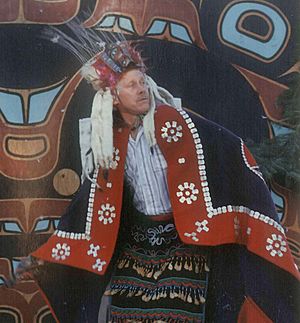Bill Holm (art historian) facts for kids
Quick facts for kids
Bill Holm
|
|
|---|---|

Holm in 1987
|
|
| Born |
Oscar William Holm Jr.
March 24, 1925 Roundup, Montana, U.S.
|
| Died | December 16, 2020 (aged 95) |
| Other names | Kwakʼwala: Namsgamuti |
| Occupation | Art historian |
Bill Holm (born March 24, 1925, died December 16, 2020) was an American art expert. He studied and wrote about the amazing art of Indigenous peoples from the Northwest Coast. He also made his own art in the Northwest Coast style. He even taught others about "formline" design, which is a special way of drawing.
Bill Holm was a professor of art history at the Burke Museum of Natural History and Culture. He also taught at the University of Washington in Seattle. His 1965 book, Northwest Coast Indian Art: An Analysis of Form, became a very important book. It helped many people learn about this art style.
Early Life and Learning About Art
Bill Holm was born on March 24, 1925, in Roundup, Montana. When he was twelve, his family moved to Seattle. Before becoming an artist and art historian, Holm served in the army during World War II. He was a Master sergeant in France.
In 1953, Holm married his wife, Marty. They became good friends with Mungo Martin, a respected elder from the Kwakwaka'wakw people. This friendship led to many important art projects. They recorded hundreds of Kwakwaka'wakw songs. They also helped build "big houses" and totem poles on Lopez Island and John's Island. They made many dance masks and even four Haida-style canoes.
The Kwakwaka'wakw people gave Bill Holm several special names. These names included Namsgamuti (He Speaks Only Once) and Ho'miskanis (Plenty of Everything). He was also named Tlalelitla (Continually Inviting) by important chiefs. Bill Holm also taught many students, including the famous Haida carver Freda Diesing.
Awards and Recognition
Bill Holm wrote eight books about art. These books won many awards. He received four Washington State Governor's Writers Awards. He also got two special Governor's awards.
In 2001, the Tlingit, Haida, and Tsimshian people honored him. They gave him a certificate of appreciation. This showed how much they valued his work. The Native American Art Studies Association also gave him an Honor Award in 1991. The University of Washington recognized him with a Distinguished Achievement Award in 1994. He also received the Burke award in 2010.
His Own Art
Bill Holm was also a talented artist himself. He created a series of large paintings. These paintings showed Northwest Native designs. They were displayed at the 1962 Seattle World's Fair. His artwork is featured in a book called Sun Dogs and Eagle Down, The Indian Paintings of Bill Holm.
Images for kids

